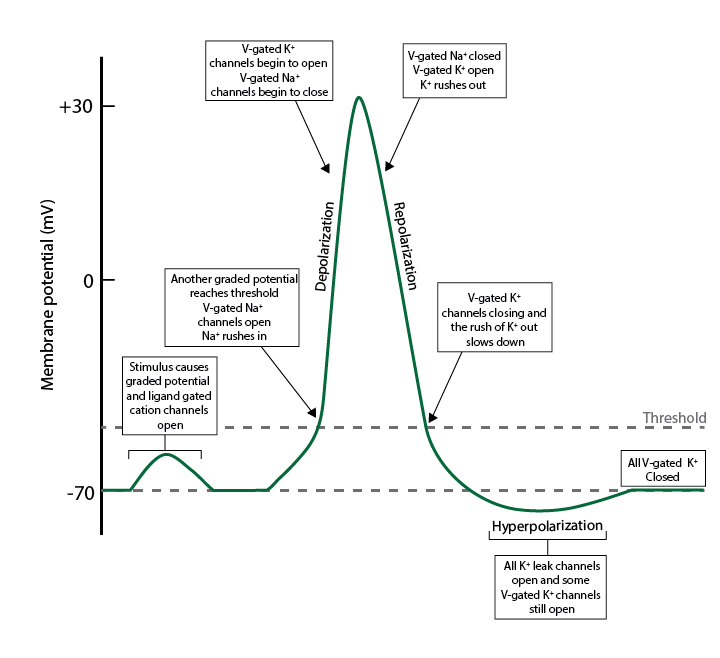CELL MEMBRANES-ELECTROPHYSIOLOGY
ACTION POTENTIALS
An action potential is where things really become interesting and exciting ... no pun intended. The action potential represents a rapid change in the membrane potential, followed by a rapid return to the resting membrane potential (see figure below). In other words, a rapid depolarization followed by a rapid repolarization. The action potential is the basis of transmitting signals in nerve cells, inducing muscle contraction and perception of all our senses. The action potential is caused by the activation of the voltage-gated ion channels, most often the Na+ voltage-gated ion channel.
Most commonly, we talk about action potentials as they relate to nerve cells. In nerve cells, at rest, the movement of Na+ through the membrane is extremely low (very few Na+ leak channels). However, if the surface (cell membrane) of the neuron receives a graded potential that is sufficient to exceed the set threshold value, the voltage sensitive proteins will respond by changing conformation. Because the concentration of Na+ is extremely high on the outside of the cell, the opening of Na+ channels will cause a rapid influx of Na+ down its concentration gradient, therefore disrupting the negative membrane potential and resulting in depolarization. The membrane potential will increase rapidly in response to the increased positive charge until the inactivated Na+ voltage-gated channels close. It is important to note that depolarization occurs with minimal changes in the overall concentration of Na+ or K+ (Only one out of every 100,000 Na+ ions need to enter the cell to produce a 100 mV change in potential).
Once activated, the protein channel is quick to re-establish a new conformation, but during the interim (about 0.5 msec), the protein allows sodium to pass through the membrane. In the case of the Na+ channel, there are two gates, an activation gate and an inactivation gate. The activation gate is very sensitive to voltage changes and is the basis of threshold. The inactivation gate is slightly delayed compared to the activation gate, which allows for the channel to be permeable for a brief moment. After a slight delay, voltage-gated K+ channels open, resulting in an efflux of potassium out of the cell. This efflux is in addition to the efflux resulting from K+ leak channels that are always open. The additional efflux of potassium, in combination with the termination of Na+ (because the inactivation gate closes) influx reverses the initial depolarization and the membrane potential moves back towards the resting potential (repolarization) and even beyond (hyperpolarization), after which the K+ voltage channels close and the resting membrane is reestablished (the potassium channels have only one gate which is activated by depolarization and inactivated by repolarization). Hyperpolarization occurs because of the additional movement of K+ through the voltage-gated K+ channel. Once the voltage-gated K+ channel closes, the membrane will return to the resting potential established initially by the leak channels for K+. The small depletions that occur in K+ and Na+ concentrations, following each action potential, are then reestablished by the Na+/K+ ATPase pump, but this is not necessary for another action potential. In fact, it has been demonstrated that the ion gradients in a neuron are sufficient to be able to generate 10,000 action potentials without replenishment from the Na+/K+ ATPase pump. It is important to note that in order for activation of the Na+ channels to occur, there needs to be a sufficient stimulus of current that exceeds the threshold value. For example, the threshold value for a typical neuron is near -55 mV, while the resting membrane potential is near -70 mV. If a graded potential is not sufficient to bring the membrane up to the threshold value (-55 mV), then an action potential cannot be initiated. This kind of stimulus is referred to as a sub-threshold stimulus. If the threshold value is exceeded by a given stimulus, the action potential will always occur. This phenomenon is referred to as the all-or-nothing principle. In addition, unlike graded potentials, the action potential cannot be summed or added upon, but once an action potential starts, it becomes self-propagating.

Image created by BYU-I student, Kaylynn Loyd 2013
When current stimulus is sufficient to reach the threshold value, an action potential is triggered. Notice that the first stimulus came close but did not exceed threshold. This stimulus failed to initiate an action potential. However, the second stimulus must have exceeded threshold because a relatively large and rapid depolarization occurred, followed by a rapid repolarization.
**You may use the buttons below to go to the next or previous reading in this Module**


